Research on the Impact of Air Temperature and Wind Speed on Ventilation in University Dormitories under Different Wind Directions (Northeast China)
Abstract
:1. Introduction
2. Model and Methods
2.1. Theoretical Equations
2.2. Physical Model
2.3. Evaluation Method
2.4. Settings
2.5. CFD Verification
2.6. Applicability
3. Results and Discussion
3.1. Phenomena
- Case 1 S Wind Direction
- Case 2 SW Wind Direction
- Case 3 W Wind Direction
3.2. Equations
4. Tests and Discussion
5. Conclusions
Author Contributions
Funding
Data Availability Statement
Acknowledgments
Conflicts of Interest
Nomenclature
| Density | |
| Time | |
| the effective turbulent viscosity | |
| The inverse effective Prandtl numbers | |
| User-defined source term | |
| Contribution of fluctuating expansion to the total dissipation rate | |
| 100 | |
| Coefficient of aerodynamic viscosity of air | |
| Schmidt number | |
| Mass fraction | |
| Coefficient of viscosity of air turbulence | |
| Particle size | |
| Turbulent energy | |
| the turbulent dispassion rate | |
| the inverse effective Prandtl numbers for k equation | |
| The turbulent kinetic energy produced by buoyancy | |
| User-defined source term | |
| The turbulent kinetic energy produced by the average velocity gradient | |
| 4.38 | |
| The location of the center of the grid from the wall | |
| Velocity vector | |
| 0.012 |
References
- Saeedi, R.; Ahmadi, E.; Hassanvand, M.S.; Mohasel, M.A.; Yousefzadeh, S.; Safari, M. Implemented indoor airborne transmission mitigation strategies during COVID-19: A systematic review. J. Environ. Health Sci. Eng. 2023, 21, 11–20. [Google Scholar] [CrossRef]
- Xu, L.; Hu, Y.; Liang, W. Subjective and objective sensory assessments of indoor air quality in college dormitories in Nanjing. Build. Environ. 2022, 212, 108802. [Google Scholar] [CrossRef]
- Yang, Z.; Shen, J.; Gao, Z. Ventilation and Air Quality in Student Dormitories in China: A Case Study during Summer in Nanjing. Int. J. Environ. Res. Public Health 2018, 15, 1328. [Google Scholar] [CrossRef]
- Liu, L.; Wang, L.; Zhang, Y.; Dong, B.; Song, B. Study on Ventilation Rates at University Dormitories in Winter. Procedia Eng. 2015, 121, 743–748. [Google Scholar] [CrossRef]
- Fisk, W.J.; Black, D.; Brunner, G. Changing ventilation rates in U.S. offices: Implications for health, work performance, energy, and associated economics. Build. Environ. 2011, 47, 368–372. [Google Scholar] [CrossRef]
- Sarkhosh, M.; Najafpoor, A.A.; Alidadi, H.; Shamsara, J.; Amiri, H.; Andrea, T.; Kariminejad, F. Indoor Air Quality associations with sick building syndrome: An application of decision tree technology. Build. Environ. 2020, 188, 107446. [Google Scholar] [CrossRef]
- Surawattanasakul, V.; Sirikul, W.; Sapbamrer, R.; Wangsan, K.; Panumasvivat, J.; Assavanopakun, P.; Muangkaew, S. Respiratory Symptoms and Skin Sick Building Syndrome among Office Workers at University Hospital, Chiang Mai, Thailand: Associations with Indoor Air Quality, AIRMED Project. Int. J. Environ. Res. Public Health 2022, 19, 10850. [Google Scholar] [CrossRef]
- Hou, J.; Sun, Y.; Dai, X.; Liu, J.; Shen, X.; Tan, H.; Yin, H.; Huang, K.; Gao, Y.; Lai, D.; et al. Associations of indoor carbon dioxide concentrations, air temperature, and humidity with perceived air quality and sick building syndrome symptoms in Chinese homes. Indoor Air 2021, 31, 1018–1028. [Google Scholar] [CrossRef]
- Xu, X.; Lian, Z.; Shen, J.; Cao, T.; Zhu, J.; Lin, X.; Qing, K.; Zhang, W.; Zhang, T. Experimental study on sleep quality affected by carbon dioxide concentration. Indoor Air 2020, 31, 440–453. [Google Scholar] [CrossRef]
- Sundell, J.; Anderson, B.; Anderson, K.; Lindvall, T. Volatile Organic Compounds in Ventilating Air in Buildings at Different Sampling Points in the Buildings and their Relationship with the Prevalence of Occupant Symptoms. Indoor Air 1993, 3, 82–93. [Google Scholar] [CrossRef]
- Subramanian, P.; Reynolds, S.; Breuer, G.; Whitten, P. Analysis of limonene as an indicator for the assessment of environmental air-quality and health symptoms in office buildings. J. Environ. Sci. Health Part A 2000, 35, 999–1019. [Google Scholar] [CrossRef]
- Lan, L.; Pan, L.; Lian, Z.; Huang, H.; Lin, Y. Experimental study on thermal comfort of sleeping people at different air temperatures. Build. Environ. 2014, 73, 24–31. [Google Scholar] [CrossRef]
- Shaughnessy, R.J.; Levetin, E.; Blocker, J.; Sublette, K.L. Effectiveness of Portable Indoor Air Cleaners: Sensory Testing Results. Indoor Air 1994, 4, 179–188. [Google Scholar] [CrossRef]
- Lei, Z.; Liu, C.; Wang, L.; Li, N. Effect of natural ventilation on indoor air quality and thermal comfort in dormitory during winter. Build. Environ. 2017, 125, 240–247. [Google Scholar] [CrossRef]
- Li, H.; Li, X.; Qi, M. Field testing of natural ventilation in college student dormitories (Beijing, China). Build. Environ. 2014, 78, 36–43. [Google Scholar] [CrossRef]
- Sun, Y.X. On the Association between Dorm Environmental Factors and Allergies among College Students; Tianjin University: Tianjin, China, 2008. [Google Scholar]
- Chen, Q. Design of Natural Ventilation with CFD; Springer: Dordrecht, The Netherlands, 2006; Volume 9, pp. 116–123. [Google Scholar] [CrossRef]
- Cheung, J.O.P.; Liu, C.H. CFD simulations of natural ventilation behaviour in high-rise buildings in regular and staggered arrangements at various spacings. Energy Build. 2011, 43, 1149–1158. [Google Scholar] [CrossRef]
- Hooff, T.V.; Blocken, B.; Aanen, L.; Bronsema, B. A venturi-shaped roof for wind-induced natural ventilation of buildings: Wind tunnel and CFD evaluation of different design configurations. Build. Environ. 2011, 46, 1797–1807. [Google Scholar] [CrossRef]
- Dai, Y.; Xu, D.; Wang, H.; Zhang, F. CFD Simulations of Ventilation and Interunit Dispersion in Dormitory Complex: A Case Study of Epidemic Outbreak in Shanghai. Int. J. Environ. Res. Public Health 2023, 20, 4063. [Google Scholar] [CrossRef]
- Kai, Z.; Peter, O.; Wen, L.Y.; Jing, Z.T. Ventilation in worker dormitories and its impact on the spread of respiratory droplets. Sustain. Cities Soc. 2021, 75, 103327. [Google Scholar] [CrossRef]
- Wang, L. Research on Indoor Thermal Environment of Dormitory in Chongqing; College of Urban Construction & Environmental Engineering of Chongqing University: Chongqing, China, 2009. [Google Scholar]
- Sin, C.H.; Jon, K.S.; Un, G.H.; Thae, Y.I.; Kim, H.; Tokgo, J.; Ri, H.M. Evaluation of the ventilation and pollutant exposure risk level inside 3D street canyon with void deck under different wind directions. Environ. Sci. Pollut. Res. Int. 2023, 30, 61808. [Google Scholar] [CrossRef]
- Jon, K.S.; Luo, Y.; Sin, C.H.; Cui, P.Y.; Huang, Y.D.; Tokgo, J. Impacts of wind direction on the ventilation and pollutant dispersion of 3D street canyon with balconies. Build. Environ. 2023, 230, 110034. [Google Scholar] [CrossRef]
- Lee, K.Y.; Mak, C.M. Effects of different wind directions on ventilation of surrounding areas of two generic building configurations in Hong Kong. Indoor Built Environ. 2022, 31, 414–434. [Google Scholar] [CrossRef]
- Ou, J.; Wang, X.; Ming, Y.; Sun, X. Study on the Influence of Ventilation Speed on Smoke and Temperature Characteristics of Complex Underground Spaces. Fire 2023, 6, 11. [Google Scholar] [CrossRef]
- Su, L.; Ouyang, J.; Yang, L. Mixed-Mode Ventilation Based on Adjustable Air Velocity for Energy Benefits in Residential Buildings. Energies 2023, 16, 2746. [Google Scholar] [CrossRef]
- Ahmad, A.A.; Djimantoro, M.I.; Suryawinata, B.A. The Effect of Local Wind Speed for Opening in Mega Kuningan Highrise Office Tower. IOP Conf. Ser. Earth Environ. Sci. 2021, 794, 012194. [Google Scholar] [CrossRef]
- Li, Z.; Li, K.; Chang, J.; Wu, H.; Liu, J. Numerical simulation the effect of natural ventilation on Indoor Environment Quality in the inner-corridor-type student dormitory in winter. IOP Conf. Ser. Mater. Sci. Eng. 2019, 609, 042016. [Google Scholar] [CrossRef]
- Wu, Z.; Li, N.; Wargocki, P.; Peng, J.; Li, J.; Cui, H. Adaptive thermal comfort in naturally ventilated dormitory buildings in Changsha, China. Energy Build. 2019, 186, 56–70. [Google Scholar] [CrossRef]
- Hu, Y.; Wu, Y.; Wang, Q.; Hang, J.; Li, Q.; Liang, J.; Ling, H.; Zhang, X. Impact of Indoor-Outdoor Temperature Difference on Building Ventilation and Pollutant Dispersion within Urban Communities. Atmosphere 2021, 13, 28. [Google Scholar] [CrossRef]
- Wu, J.; Wang, J.; Cheng, Z. Air Distribution Simulation of Natural Ventilation in Dormitory. In Proceedings of the 2016 5th International Conference on Advanced Materials and Computer Science, Qingdao, China, 26–27 March 2016; pp. 543–548. [Google Scholar] [CrossRef]
- Ai, Z.T.; Mak, C.M. Determination of single-sided ventilation rates in multistory buildings: Evaluation of methods. Energy Build. 2014, 69, 292–300. [Google Scholar] [CrossRef]
- Ministry of Education [2001] No. 12; Several Opinions on the Construction Standards of College Students’ Apartments. Ministry of Education of China: Beijing, China, 2001.
- GB 55025-2022; Dormitory and Hotel Building Project Specifications. Ministry of Housing and Urban-Rural Development: Beijing, China, 2022.
- Franke, J.; Hellsten, A.; Schlunzen, K.H.; Carissimo, B. The COST 732 Best Practice Guideline for CFD simulation of flows in the urban environment: A summary. Int. J. Environ. Pollut. 2011, 44, 419–427. [Google Scholar] [CrossRef]
- Tominaga, Y.; Mochida, A.; Yoshie, R.; Kataoka, H.; Nozu, T.; Yoshikawa, M.; Shirasawa, T. AIJ guidelines for practical applications of CFD to pedestrian wind environment around buildings. J. Wind. Eng. Ind. Aerodyn. 2008, 96, 1749–1761. [Google Scholar] [CrossRef]
- Mats, S. What is ventilation efficiency? Build. Environ. 1981, 16, 473–481. [Google Scholar] [CrossRef]
- Liu, X.; Yang, L.; Niu, S.; Qin, W.; Qian, F. Research on the effect of different position on classroom ventilation in a L type teaching building. J. Build. Eng. 2020, 33, 101852. [Google Scholar] [CrossRef]
- Yang, L.; Liu, X.; Qian, F.; Du, S. Ventilation effect on different position of classrooms in “line” type teaching building. J. Clean. Prod. 2019, 209, 886–902. [Google Scholar] [CrossRef]
- Zhang, G.H.; Fan, Y.B.; Yang, R.S.; Li, S.H. Application of the Rosin-Rammler function to describe quartz sandstone particle size distribution produced by high-pressure gas rapid unloading at different infiltration pressure. Powder Technol. 2022, 412, 117982. [Google Scholar] [CrossRef]
- Duan, W.; Liu, Z.; Liu, P.; Hui, L. Estimation of Acid-Hydrolyzed Cellulose Fiber Size Distribution with Exponential and Rosin-Rammler (R-R) Laws. BioResources 2018, 13, 7792–7804. [Google Scholar] [CrossRef]
- Chen, J.; Augenbroe, G.; Wang, Q.; Song, X. Uncertainty Analysis of Thermal Comfort in a Prototypical Naturally Ventilated Office Building and Its Implications Compared to Deterministic Simulation. Energy Build. 2017, 146, 283–294. [Google Scholar] [CrossRef]
- Udrea, I.; Croitoru, C.; Nastase, I.; Dogeanu, A.; Badescu, V. Thermal Comfort Analyses In Naturally Ventilated Buildings. Math. Model. Civ. Eng. 2014, 3, 64–70. [Google Scholar] [CrossRef]
- GB/T 50378-2019; Green Building Assessment Standards. Ministry of Housing and Urban-Rural Development: Beijing, China, 2019.
- Etheridge, D. A perspective on fifty years of natural ventilation research. Build. Environ. 2015, 91, 51–60. [Google Scholar] [CrossRef]
- Weng, J.; Zhang, X. Analysis of Ventilation in the Student Dormitory Based on CFD Methods. Fluid Mach. 2010, 38, 61–65. [Google Scholar] [CrossRef]
- Mott, W.; Woods, W. Natural ventilation driven by periodic gusting of wind. J. Fluid Mech. 2011, 679, 58–76. [Google Scholar] [CrossRef]
- Persily, A.; Jonge, L. Carbon dioxide generation rates for building occupants. Indoor Air 2017, 27, 868–879. [Google Scholar] [CrossRef] [PubMed]
- Shen, J.; Chen, Y.; Rajagopal, K. Enhancing Indoor Environmental Quality and Sustainability in Post-Pandemic Office Settings: A Study on Displacement Ventilation Feasibility. Buildings 2023, 13, 3110. [Google Scholar] [CrossRef]

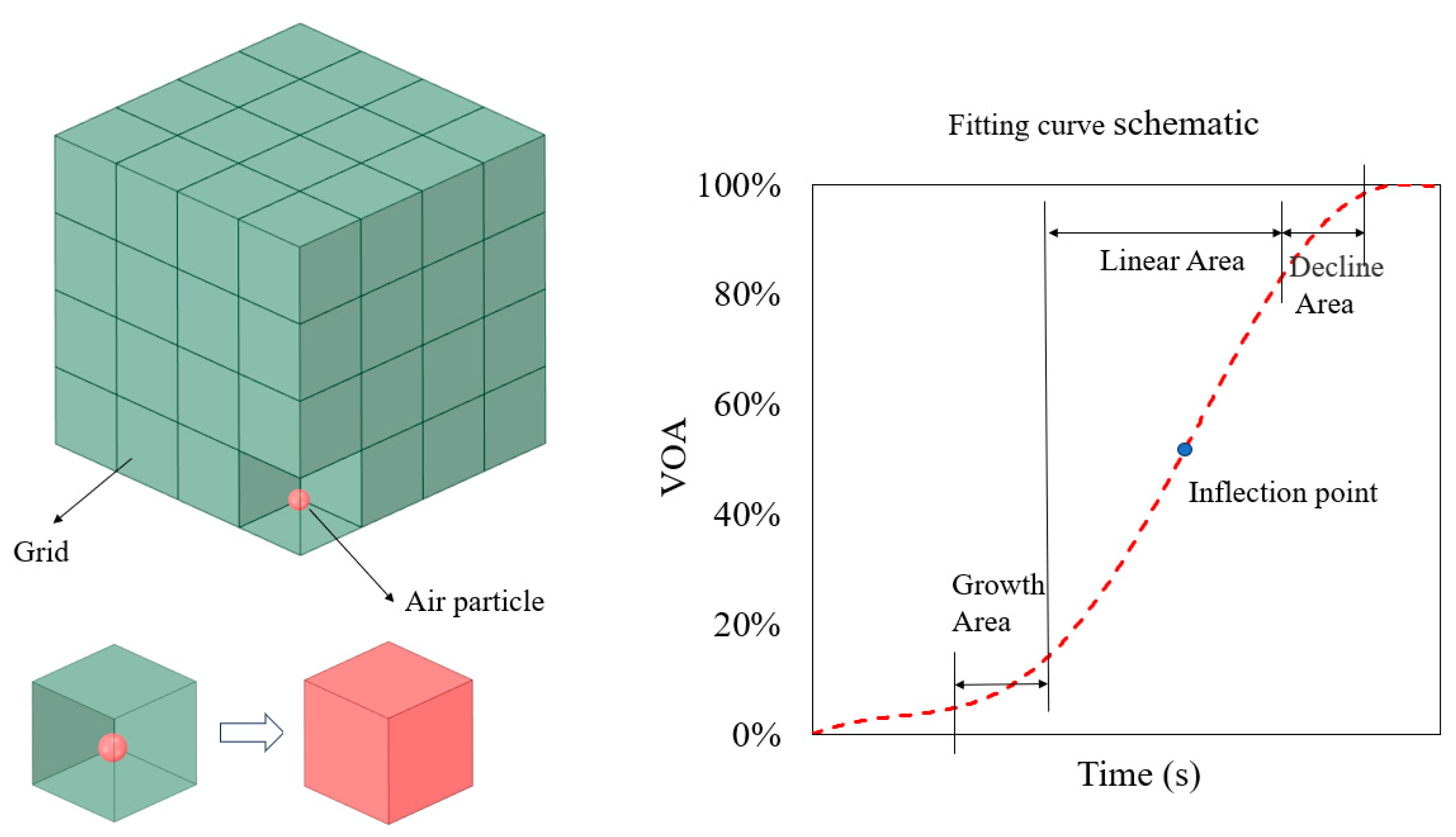
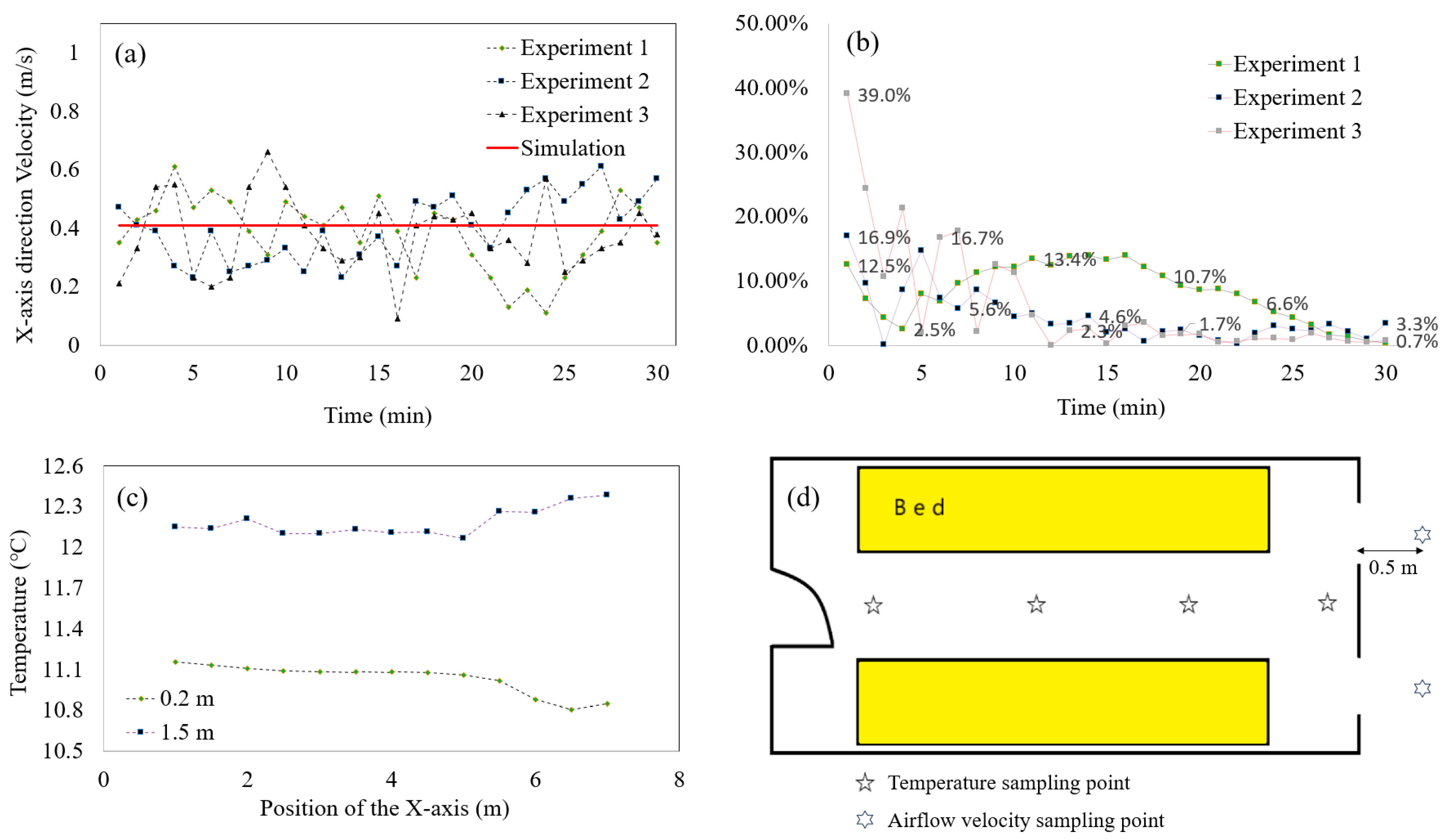


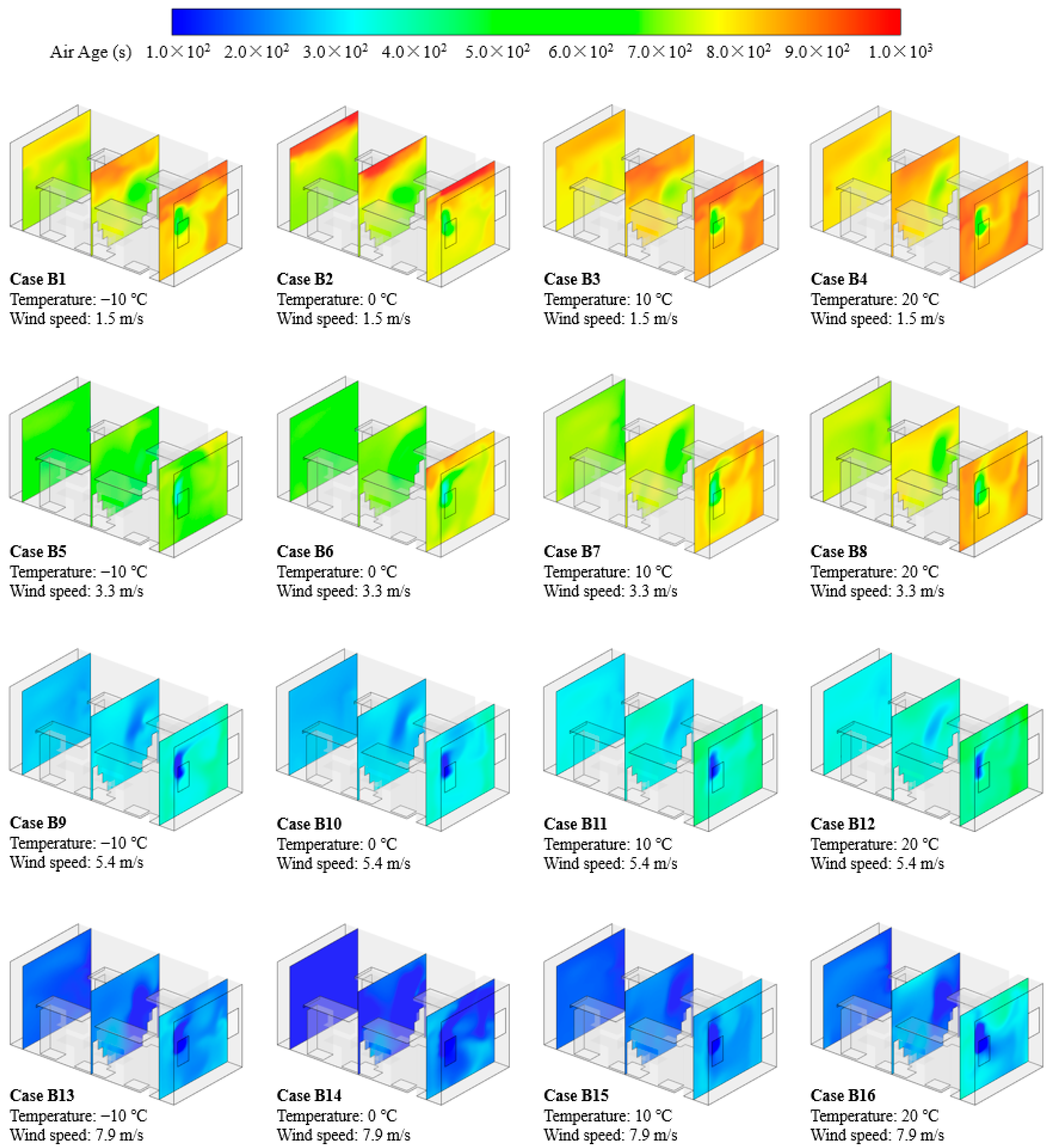
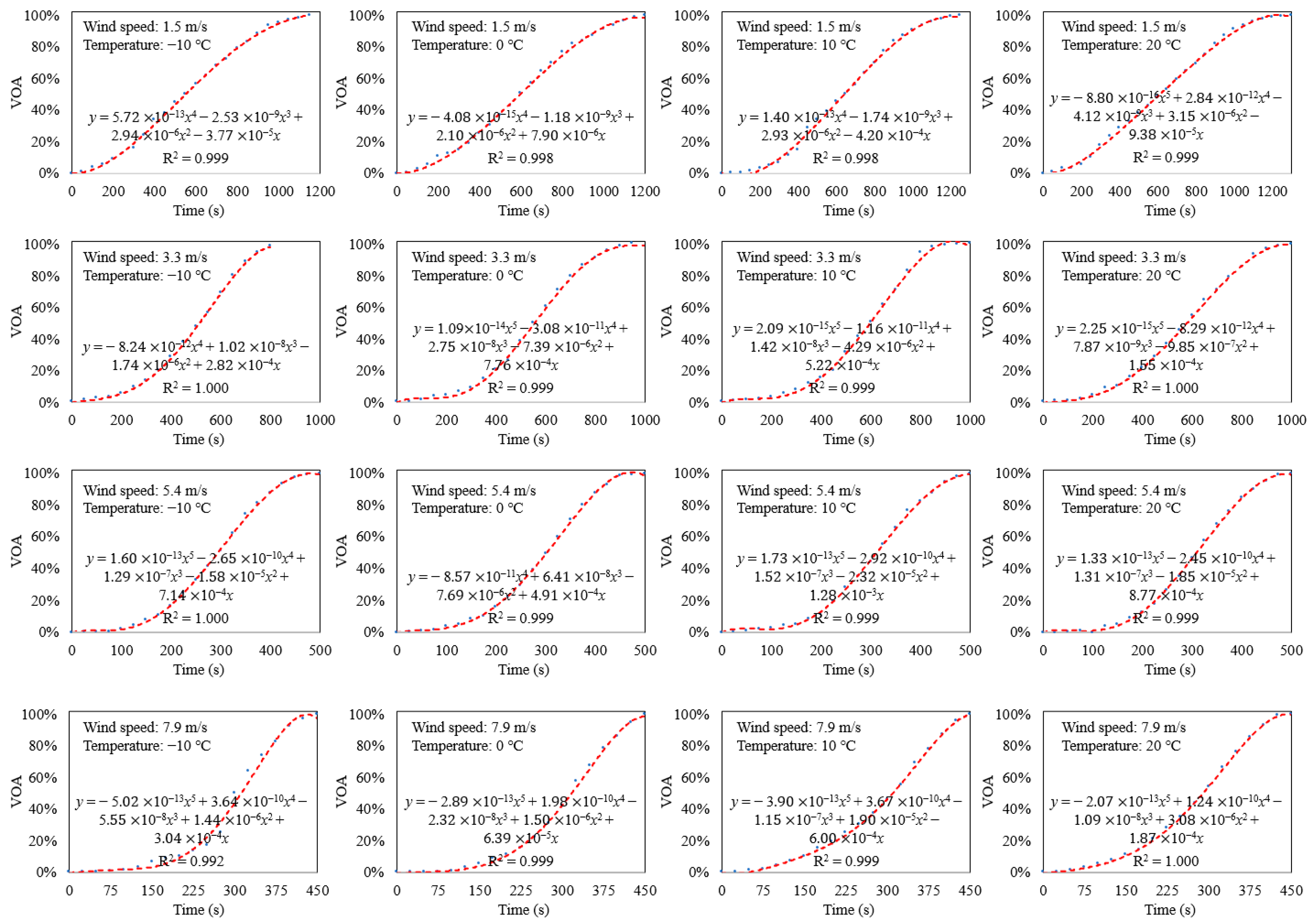

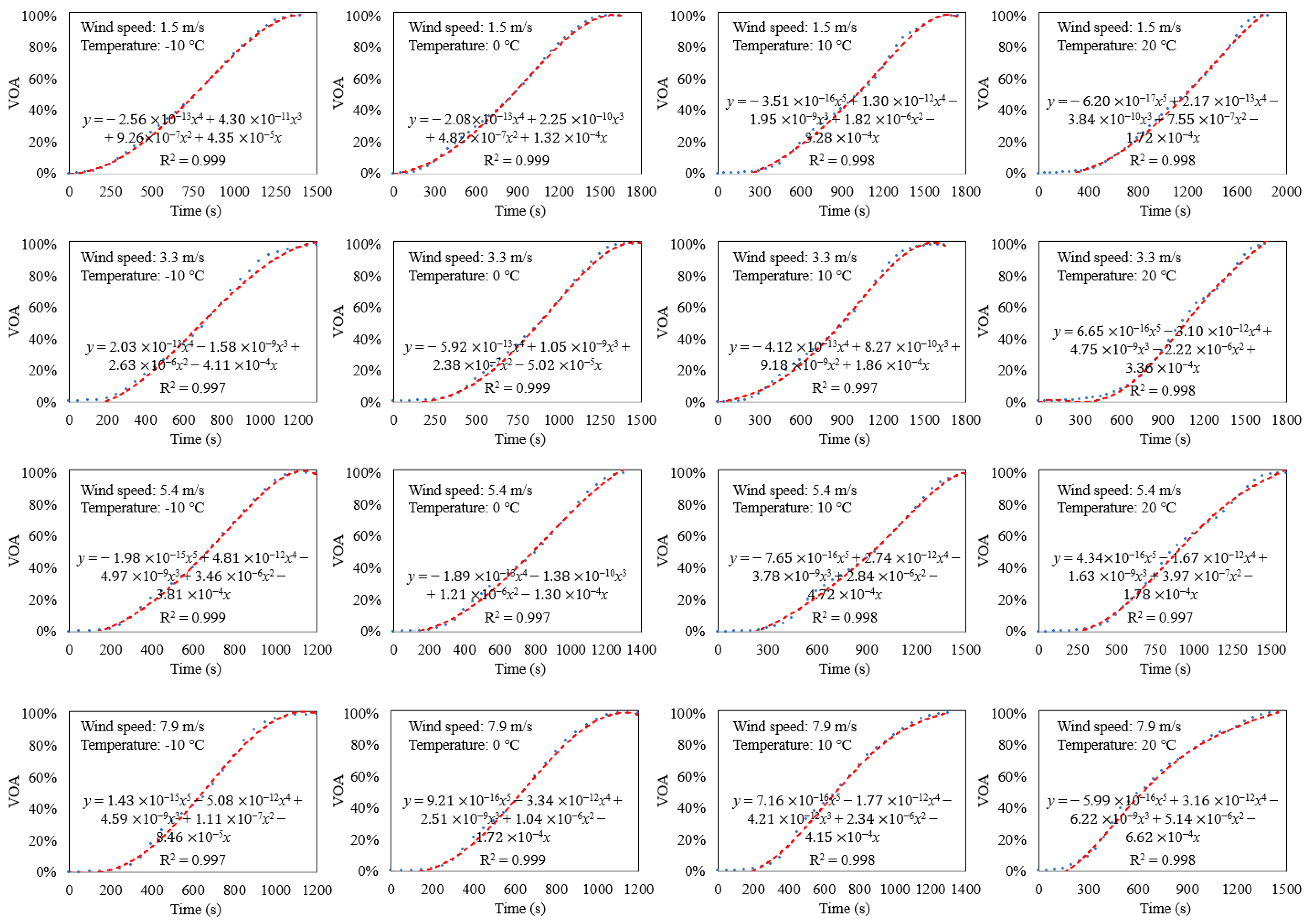
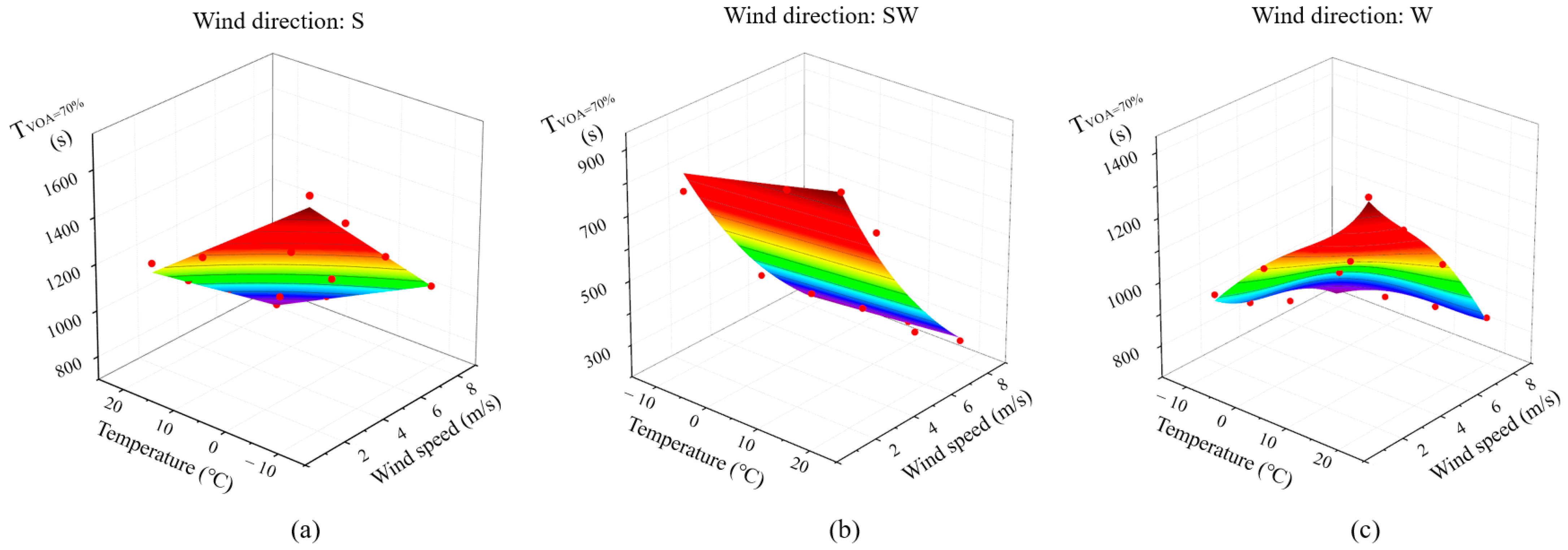


| Feature | Value | Note |
|---|---|---|
| Room air temperature | Average 22 °C | Measurements. |
| Body temperature | 36.5 °C | Replace the human body with a bed surface and emit heat. |
| Ambient mean air pressure | 99,342 Pa | |
| Initial air pressure difference between indoor and outdoor | −5 Pa~0 Pa | |
| Ambient wind direction | W (0°); SW (45°); S (90°) | Due to the geometric symmetry of the building and considering people’s habits of using the basic wind direction, the focus is on these three wind directions. |
| Ambient wind speed | 1.5 m/s; 3.3 m/s; 5.4 m/s; 7.9 m/s | The Beaufort Wind Scale ranges from wind force 1 to 4. |
| Outdoor temperature | −10 °C; 0 °C; 10 °C; 20 °C | Assume. |
| Calculation scheme | Coupled | |
| Pressure solution | PRESTO! | |
| Momentum and energy discretization scheme | Second order upwind | |
| Gas definition | Incompressible-ideal-gas | Ideal for thermal diffusion. |
| Wind Speed | Outdoor Temperature | |||
|---|---|---|---|---|
| −10 °C | 0 °C | 10 °C | 20 °C | |
| 1.5 m/s | 1181 s | 1290 s | 1434 s | 1706 s |
| 3.3 m/s | 1028 s | 1203 s | 1317 s | 1519 s |
| 5.4 m/s | 897 s | 949 s | 1111 s | 1290 s |
| 7.9 m/s | 716 s | 839 s | 977 s | 1055 s |
| Wind Speed | Outdoor Temperature | |||
|---|---|---|---|---|
| −10 °C | 0 °C | 10 °C | 20 °C | |
| 1.5 m/s | 759 s | 821 s | 876 s | 925 s |
| 3.3 m/s | 656 s | 701 s | 725 s | 752 s |
| 5.4 m/s | 379 s | 381 s | 396 s | 384 s |
| 7.9 m/s | 280 s | 272 s | 273 s | 275 s |
| Wind Speed | Outdoor Temperature | |||
|---|---|---|---|---|
| −10 °C | 0 °C | 10 °C | 20 °C | |
| 1.5 m/s | 945 s | 1087 s | 1205 s | 1418 s |
| 3.3 m/s | 862 s | 1045 s | 1113 s | 1267 s |
| 5.4 m/s | 801 s | 953 s | 1074 s | 1098 s |
| 7.9 m/s | 768 s | 796 s | 825 s | 851 s |
| Wind Direction | Outside Air Temperature | Wind Speed | Data Graph | The Value of ‘t’ (Equation (22)) | The Ratio of Carbon Dioxide Concentration Change |
|---|---|---|---|---|---|
| S | 6 °C | 2.2 m/s | Figure 12a | 30 min | 72.0% |
| S | 10 °C | 1.7 m/s | Figure 12b | 35 min | 79.9% |
| SW | 14 °C | 3.8 m/s | Figure 12c | 15 min | 77.1% |
| SW | 8 °C | 1.7 m/s | Figure 12d | 19 min | 81.1% |
| W | 4 °C | 1.9 m/s | Figure 12e | 25 min | 71.1% |
| W | 12 °C | 1.8 m/s | Figure 12f | 31 min | 74.8% |
Disclaimer/Publisher’s Note: The statements, opinions and data contained in all publications are solely those of the individual author(s) and contributor(s) and not of MDPI and/or the editor(s). MDPI and/or the editor(s) disclaim responsibility for any injury to people or property resulting from any ideas, methods, instructions or products referred to in the content. |
© 2024 by the authors. Licensee MDPI, Basel, Switzerland. This article is an open access article distributed under the terms and conditions of the Creative Commons Attribution (CC BY) license (https://creativecommons.org/licenses/by/4.0/).
Share and Cite
Cheng, Y.; Yang, M.; Xie, S.; Liu, J.; Zheng, S. Research on the Impact of Air Temperature and Wind Speed on Ventilation in University Dormitories under Different Wind Directions (Northeast China). Buildings 2024, 14, 361. https://doi.org/10.3390/buildings14020361
Cheng Y, Yang M, Xie S, Liu J, Zheng S. Research on the Impact of Air Temperature and Wind Speed on Ventilation in University Dormitories under Different Wind Directions (Northeast China). Buildings. 2024; 14(2):361. https://doi.org/10.3390/buildings14020361
Chicago/Turabian StyleCheng, Yanzhe, Mingxin Yang, Songgao Xie, Jiaqi Liu, and Sheng Zheng. 2024. "Research on the Impact of Air Temperature and Wind Speed on Ventilation in University Dormitories under Different Wind Directions (Northeast China)" Buildings 14, no. 2: 361. https://doi.org/10.3390/buildings14020361




